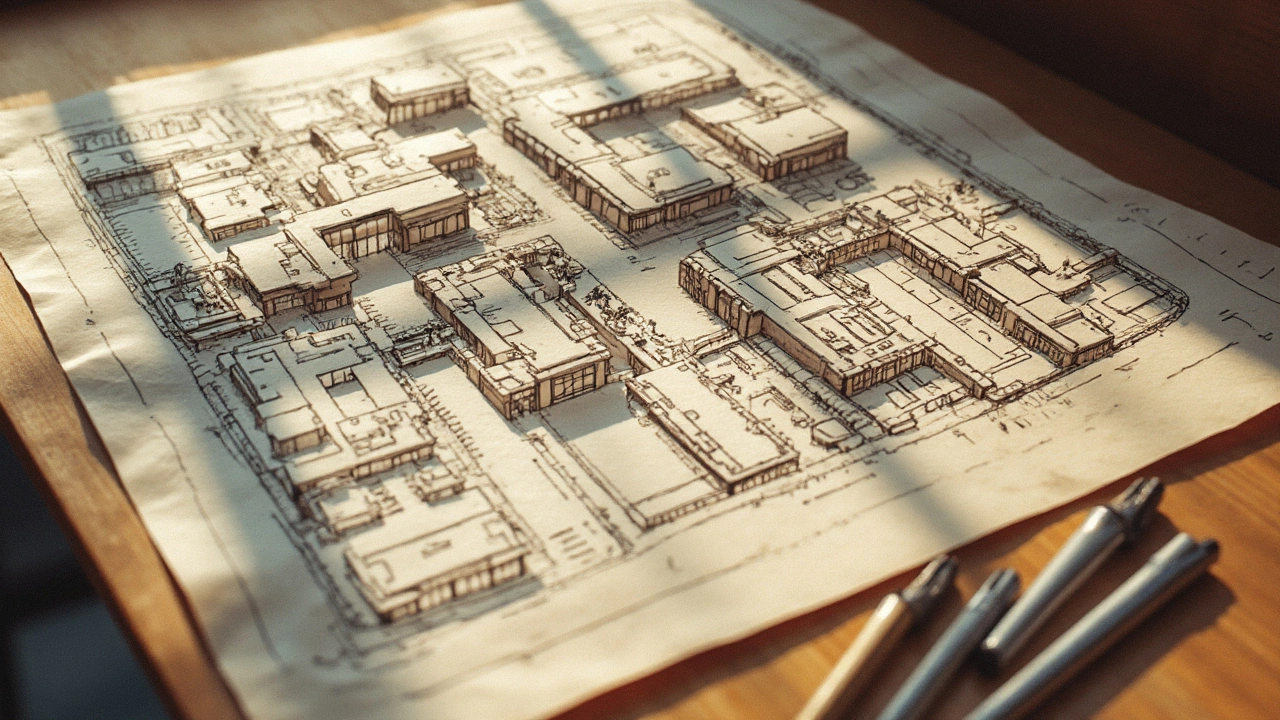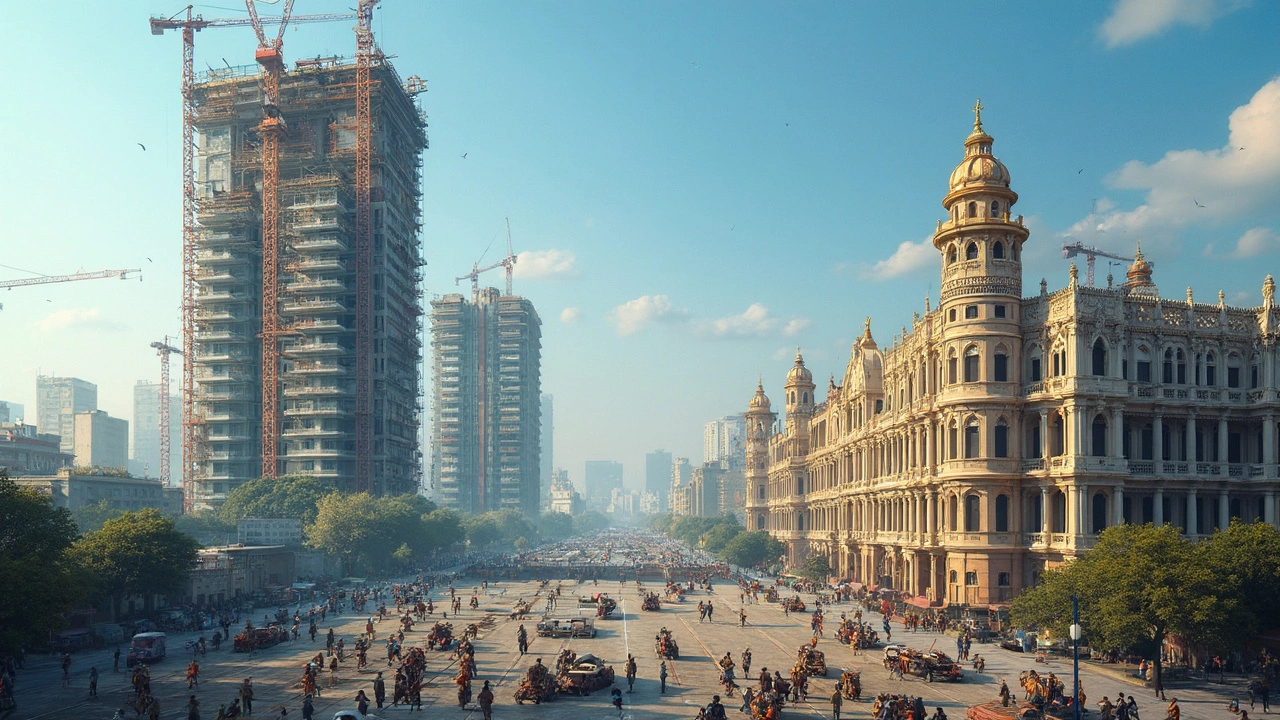When folks hear 'commercial' and 'non-residential,' they often think they mean the same thing, right? Not exactly. While they might overlap a bit, they cater to different needs in the construction world.
Commercial construction focuses on places where business happens, like your favorite downtown café or the local shopping center. It's all about facilitating trade and services. Non-residential, on the other hand, includes anything that isn’t a home. Think about schools, hospitals, or even a factory down the road.
Doesn't sound so different yet? Well, here's where it gets interesting. Each has its specific codes, market demands, and even unique design challenges. By the end of this read, you'll get why this distinction matters and how it can affect your next building project.
- Defining Commercial and Non-Residential
- Types of Commercial Buildings
- Types of Non-Residential Structures
- Key Differences in Regulations and Codes
- Market Demands and Trends
- Choosing the Right Path: Commercial vs. Non-Residential
Defining Commercial and Non-Residential
Alright, so we're diving into what really makes up commercial construction versus non-residential buildings. These terms might seem like they could be interchanged without a second thought, but they actually fit into distinct categories in the construction world.
What is Commercial Construction?
Commercial construction is all about spaces where business activity occurs. We're talking about places like office buildings, shopping centers, restaurants, and hotels. The key thing here is commerce—providing spaces designed to support, you guessed it, commercial activities. The design and functionality of these buildings are all about facilitating business, trade, and consumption.
The Scope of Non-Residential Buildings
Then you have non-residential buildings. This is a broader category that includes anything that's not meant for living. It covers educational buildings like schools and universities, medical facilities such as hospitals, institutional structures like museums, and even some industrial facilities. Sure, commercial buildings are technically non-residential since they aren’t homes, but not all non-residential buildings are commercial.
To give you a clearer picture, imagine a bustling high-rise office building in the city center—that's commercial. Compare that to the local public library or community college across town—those are non-residential but not commercial. Make sense?
Why This Matters
Understanding the difference is crucial because each type of building follows different regulations and codes. For instance, commercial buildings often must comply with strict business traffic and accessibility standards. Meanwhile, a non-residential facility like a school might face different regulations related to safety and student capacity.
So, next time you hear these terms throw around, remember they're not just fancy words. They're keys to understanding the purpose, design, and requirements of the spaces that make up our cities.
Types of Commercial Buildings
When it comes to commercial construction, it covers a wide range of buildings, each serving different business needs. So, what kinds of places are we talking about? From the bustling office buildings downtown to the neighborhood shopping centers, commercial buildings come in all shapes and sizes.
Office Buildings
Office buildings are a cornerstone of commercial construction. You’ll find everything from towering skyscrapers to small office parks. These spaces focus on providing work areas for professionals like lawyers, tech companies, or financial firms. Many include handy features like shared meeting rooms and cafeterias.
Retail Centers
Retail centers or shopping malls are designed for consumer shopping. They can range from the mega malls with hundreds of stores to a strip mall with just a few shops. Retail spaces are all about maximizing the customer's shopping experience, often featuring anchor tenants like major department stores to draw crowds.
Warehouses and Industrial Buildings
Warehouses are vital for storage and distribution, especially with the boom in online shopping. Some commercial buildings also include industrial spaces for manufacturing. These aren't your typical workplaces; they're all about functionality, with wide-open spaces and special loading docks.
Hotels and Hospitality
Then there's the hotel sector. This includes everything from luxurious resorts to business hotels catering to travelers. These locations focus on service and comfort, often having restaurants, conference rooms, and pools.
Facts and Figures
Here's a snapshot that might surprise you:
| Type of Building | Percentage of Commercial Real Estate (2023) |
|---|---|
| Office | 30% |
| Retail | 25% |
| Industrial | 20% |
| Hotels | 15% |
Basically, commercial buildings play a huge role in the economy, from creating jobs to supporting local businesses. Understanding these types of constructions helps investors and builders make decisions tailored to market demands.
Types of Non-Residential Structures
Non-residential structures cover a diverse world beyond the typical commercial spaces. Unlike our homes, these buildings are tailored to public use or specialized functions. Whether you're talking about education, healthcare, or industrial facilities, each type has its unique characteristics and purposes.
1. Educational Buildings
Schools and universities fall under this category. They are designed to cater to various age groups and educational activities, which means classrooms, labs, and auditoriums are just the beginning. It's all about creating a supportive learning environment.
2. Healthcare Facilities
These include hospitals, clinics, and specialized laboratories. Such structures often have strict regulations to ensure patient safety and efficient healthcare delivery. That's a whole other kettle of fish compared to your standard commercial construction with aspects like sterile environments being top priority.
3. Industrial Complexes
Factories, warehouses, and distribution centers make up the industrial scene. These structures are often bigger, focusing on space for heavy machinery, storage, and logistics. You'd be amazed at how function and safety drive every aspect of the design here.
4. Government Buildings
Think of courthouses, police stations, or city halls. They cater to public administration and governance. They often follow specific aesthetic and functional guidelines ensuring that they serve both officials and the community efficiently.
Here’s a fun fact – in the last decade, non-residential construction saw an immense push for sustainable designs, especially in government and educational structures. They are moving towards more eco-friendly and energy-efficient solutions, which spells good news for the environment.

Key Differences in Regulations and Codes
Alright, let's get into the nitty-gritty of why commercial construction and non-residential structures have their own sets of rules. Both need to meet specific building codes, but they tend to face different challenges and regulations due to their unique use cases.
Building Codes & Permits
Commercial buildings, like offices or malls, must adhere to particular codes that cover everything from electrical systems to safety exits. They're designed to ensure public safety and to handle high traffic volumes. Got that fire exit sign in mind? Yep, that's part of it!
For non-residential constructions like schools or hospitals, the focus is often more nuanced. These buildings tend to have regulations tailored to their specific function—like hygiene standards in a hospital or special access for schools. Often, they're subject to more stringent approvals before breaking ground.
Zoning Laws
Zoning plays a big part too. A commercial building has to abide by laws that determine where businesses can operate to avoid chaos in residential neighborhoods. Non-residential projects might not have businesses operating, but they still need to fit the community's plan, whether it's an industrial zone or an educational district.
Environmental Impact
This is pretty important in places like New Zealand, where nature is king. Both types might have to submit an environmental impact assessment, but a commercial project in a rural area might face more scrutiny to preserve the surroundings.
Table of Regulatory Bodies and Their Roles
| Regulatory Body | Role |
|---|---|
| Local Council | Approvals for local zoning and permits |
| Health and Safety Authority | Ensures building complies with health and safety standards |
| Environmental Agency | Evaluates environmental impact submissions |
No matter if it's a massive skyscraper or a local school you're planning, these differences show why it's crucial to understand the regulations before diving into a project. In the end, it's all about ensuring the buildings we create are safe, functional, and in harmony with their surroundings.
Market Demands and Trends
What's hot and what's not in the world of commercial construction and non-residential buildings? With the market always on the move, staying updated can make all the difference. So, let's see what's shaping these sectors right now.
Commercial Construction
In the commercial space, technology is the name of the game. Smart buildings equipped with IoT devices for energy efficiency and security are more than just trendy—they're becoming the standard. Companies are keen on reducing costs while boosting sustainability. Green tech is huge, with solar panels and smart HVAC systems popping up in new projects.
Let's not forget mixed-use developments. Spaces that combine shops, offices, and living quarters are gaining traction, especially in urban areas where space is tight. They're not just convenient; they also attract a steady stream of foot traffic, which means good news for businesses and investors alike.
Non-Residential Developments
On the non-residential front, community needs are front and center. Schools, healthcare facilities, and even recreational centers are shifting to accommodate community growth and development. There's a push for flexible design that can adapt to future needs, whether that's expanding a school or adding new wings to a hospital.
Infrastructure projects are also getting a lot of love. Governments worldwide are investing in modernizing transport networks and building renewable energy facilities. These are capital-intensive and usually have a long-term impact, making them vital for economic growth.
Trendy Stats
Here's a quick glance at some figures that capture the current mood:
| Sector | Investment Growth (%) | Trend Focus |
|---|---|---|
| Commercial | 4.5 | Smart, Green Tech |
| Non-Residential | 6.2 | Community-Centric |
These trends show that understanding where the market's heading can help you make informed decisions. Whether you're an investor or a developer, knowing what's out there and what's to come can be a game-changer.
Choosing the Right Path: Commercial vs. Non-Residential
Deciding between commercial construction and non-residential structures isn't just about picking a type of building; it's about identifying the specific needs and goals of your project. Whether you're building a chain store or a university building makes a big difference in planning and execution.
Assessing Needs and Goals
First up, think about the primary purpose of the building. If it’s for business activities like a retail store or an office tower, then commercial might be your way to go. But if the space is geared towards public or specialized use, say a school gymnasium or a community center, then you're looking at non-residential.
Understanding Legal and Regulatory Framework
Legal codes are no joke here. Commercial construction is often governed by tighter zoning laws and environmental regulations, especially if it's in a bustling city hub. Non-residential structures, though still subjected to strict rules, might deal more with safety and public accessibility codes.
Considering Market Trends
Another key point is market demand. In recent years, there's been a significant shift towards sustainable and energy-efficient buildings. Both types of constructions are riding this trend, with green buildings grabbing attention in the market. However, commercial spaces are often more pressured to adopt these changes due to consumer awareness.
Cost Implications
Budgeting is crucial. Commercial projects might require higher initial investments due to complex designs or premium locations. Non-residential structures could offer more flexibility in cost, sometimes utilizing more varied location options or simpler layouts.
| Type | Cost per Square Meter (NZD) |
|---|---|
| Commercial | 3,500 - 5,500 |
| Non-Residential | 2,000 - 4,000 |
Personal Preferences and Future Vision
Ultimately, it comes down to your vision for the project. Some developers have a knack for commercial spaces, while others prefer the eclectic nature of non-residential buildings that serve society in various ways.
Whichever path you choose, remember this: each construction comes with its own set of challenges and rewards. Think it through, consult experts, and ensure it aligns with both your dreams and practical needs.

Written by Fletcher Abernathy
View all posts by: Fletcher Abernathy